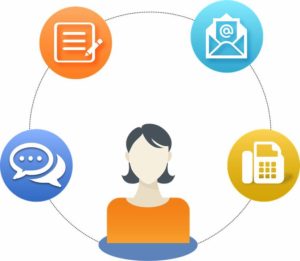
Companies often focus on the touchpoints – the precise moments when customers interact with the brand. However, this discounts the things that happen between each contact. These are the experiences that define how a customer really feels about a brand.
Oftentimes, the metrics organizations use measure only the customer’s satisfaction level during the touchpoints. This gives an incomplete picture of the whole customer experience and how they really perceive your brand. What companies should focus on is improving the entire customer journey and not just the tiny bits that comprise it.
Focusing on the Customer Journey
The customer journey accounts for all of the experiences of your customers when they’re doing business with you. From the moment they begin looking for a solution, to the point where they come across your brand, and then up through the post-sales interaction – all of these make up the customer journey. To better understand the bigger picture, agencies have developed expert mystery shopping programs that help companies define and understand the customer journey.
If your objective is to become a customer-centric organization, you have to understand the experiences a customer undergoes every time they do business with your brand. Learning the truth of how your business operations are performing and whether or not your brand needs to enhance its customer experience can help accelerate the growth of your business by improving customer service delivery.
Identifying the Customer Journey
Sadly, not many organizations truly know how to identify their customers’ journeys, much less use that information to enhance the overall customer experience. And because of this, they’re missing a lot of opportunities to improve their customer service.
Any customer journey typically consists of six phases. We’ve listed them below with a few tips on how you can enhance your customer experience journey.
1. Awareness
This is the moment where a customer first encounters your brand. They may have seen a poster, heard an announcement, glimpsed an online ad or heard about your company from a friend. The important thing is that now an impression has been made and they know you exist.
What you can do:
It might be difficult to determine which marketing tool works best for you at this moment. Inserting a clause on surveys asking people where they heard about your brand is one way to assess which marketing methods work best for your business.
2. Acquisition
This is the moment where your customers first get in touch with your organization. They may be looking into your products and services, visiting your website for more information or subscribing to your free newsletter. From someone who barely knows anything about you, they evolve into a lead that considers your business a viable option.
What you can do:
Use employees who are very knowledgeable about your brand to receive potential customers. This can help improve the customer experience and entice them to try your products or services. The important thing to remember is to make them feel as though you’re ready to help. Customers will notice if they’re just being led to make more purchases.
3. Onboarding
The moment consumers make their first purchase, they enter the onboarding phase. This is the best time to get to know them better and continue building an excellent customer journey experience. They’re at the height of curiosity and their interest in your brand has peaked. Now, you’ve been presented with an opening to get more information about them while also letting them know more about your products and services.
What you can do
Many businesses fail to proceed to the next phase due to their aggressiveness engaging a customer for a long-term relationship. This can be avoided by staying relevant and making customers feel that you genuinely want to be of service to them.
Discrepancies between what’s been promised to the customer and the actual services being delivered can create distrust in the brand, resulting in irreparable damage. This can be avoided by advertising only what you can actually deliver and not exaggerating points just to get their attention.
Some organizations teach their employees to sell the most expensive item if possible. The bad thing about this is that employees often have a hard time justifying to the customer why they should buy it. This rarely ends up in a successful sale, and if it does, customers seldom return for another purchase.
Employees must be knowledgeable about the products they’re selling. They should be trained to help customers know their options, including the associated costs, pros and cons of each selection. You should aim to at least reach this level of service in order to deliver an excellent customer experience.
4. Engagement
This is the most crucial part of the customer journey. It will take a long time to keep the customers engaged and to build loyalty to your brand.
What you can do:
You should keep them updated with your latest offers and make sure you deliver new and relevant experiences. Remember the information you gathered during the onboarding phase? You can use that to personalize content and keep them interested in doing business with you.
Time is a valuable commodity in this phase. Responses have to be fast and accurate to make sure customers remain engaged.
Empowering employees to take action and make decisions as they see fit works to the advantage of both the business and the consumers. This significantly reduces the time it takes for employees to get back to customers on their concerns and requests. It also saves the management time in handling things that should have been settled at the front desk level.
5. Retention
You have to accept that there’s always the possibility that customers will lose interest and leave your business for another. Customer journey analytics can help you identify the reasons why they’re losing interest in your business and at what points customers fall out.
What you can do:
Customer journey analytics can help you identify dips in brand loyalty. With this, you can formulate ways to get them back and prevent additional customers from leaving you. The information gathered can be used to improve existing SOP’s and prevent more customers from leaving you in the future due to those same gaps.
More often than not, it’s about the poor service quality that makes customers leave. Are you responding to concerns fast enough? How can you change their minds and get them back as your customers? Understanding both the bigger picture and the smaller details that make them want to stay with or leave your brand is crucial in retaining customers.
6. Advocacy
Allowing room for feedback provides customers the opportunity to freely express their feelings about interacting with your brand. The insights customers give can help you further improve your customer experience programs.
What you can do:
To deliver a world-class customer journey, you have to listen to what users have to say. Whether it’s positive or negative feedback, it’s always important if it comes from the consumers you serve.
Be open to communicating, even if it’s with customers who are not in your favor. It’s always the goal to deliver excellent service, but there will be hiccups along the way. Unfortunately, it’s the customers who take the hit most of the time. Businesses in return have to make amends and go the extra mile to correct the problems.
Always maintain respect for the customer, even in the most difficult times. Disrespectful customers should not be met with contempt as this can escalate the situation. Customers who had an unpleasant experience with the company can damage your brand reputation, so always show respect and try to settle things in a peaceful manner.
Customer journey analysis is no easy task. It requires the integration of data from the customer, the operations and the marketing sectors to generate a detailed picture of where things are going. It also takes a long time to develop the information needed, taking weeks to even months to complete the process. This is why many organizations hand over this undertaking to a market research agency like SeeLevel HX, which has all of the resources needed to help define the customer journey and enhance the overall customer experience through mystery shopping services.
Conclusion
If you want to understand how the customer experience affects a business, try putting yourself in their shoes and think what you’d like as a customer. Organizations that are able to make their customer experiences rewarding are able to reap the benefits, starting with more loyal customers, increased revenues and employee satisfaction, to a wider berth for correcting mistakes.
Mystery shopping companies like SeeLevel HX know how to use effectively use secret shoppers to allow organizations the opportunity to reach their fullest potentials in customer experience. Our mystery shops have proven to be effective by countless clients we’ve helped around the world. With this, we’re confident that we can do the same for your business.
Contact us for more information, or to start identifying your customer journey and how you can enhance your overall customer service.


